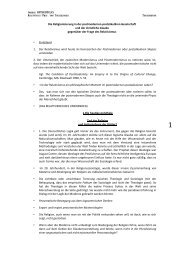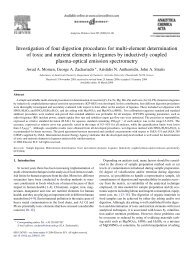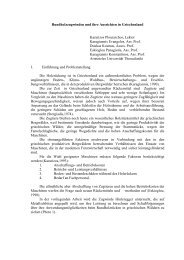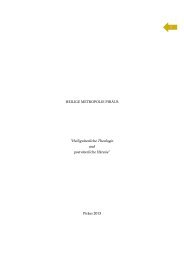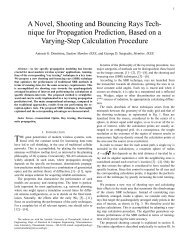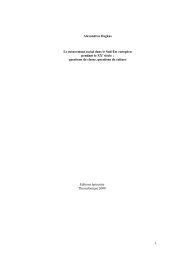an alternative proposal for the design of balanced cantilever bridges ...
an alternative proposal for the design of balanced cantilever bridges ...
an alternative proposal for the design of balanced cantilever bridges ...
You also want an ePaper? Increase the reach of your titles
YUMPU automatically turns print PDFs into web optimized ePapers that Google loves.
4 Proceedings IBSBI 2011<br />
backfill<br />
inspection<br />
opening<br />
retaining<br />
wall<br />
lowered<br />
tendons<br />
counterbal<strong>an</strong>ce<br />
c<strong>an</strong>tilever<br />
structural<br />
tie<br />
pile cap<br />
(Detail)<br />
straight<br />
tendons<br />
bearing<br />
450mm<br />
Detail<br />
Figure 2. The abutment <strong>of</strong> <strong>the</strong> proposed construction method.<br />
2,75<br />
R=30m<br />
2,75<br />
R=30m<br />
150mm<br />
The minimum height <strong>of</strong> <strong>the</strong> deck cross section is proposed to be not smaller<br />
th<strong>an</strong> 0,80 m. After <strong>the</strong> curing <strong>of</strong> <strong>the</strong> casted c<strong>an</strong>tilevers, <strong>the</strong> tendons are stressed.<br />
The <strong>design</strong> <strong>of</strong> <strong>the</strong> prestressing <strong>for</strong>ce is based on <strong>the</strong> objective <strong>of</strong> <strong>the</strong> method that<br />
is to provide a slight pre-cambering <strong>of</strong> <strong>the</strong> c<strong>an</strong>tilevers that is a slight bending<br />
deflection upwards. There<strong>for</strong>e, at this stage <strong>the</strong> c<strong>an</strong>tilevers <strong>of</strong> <strong>the</strong> deck are set<br />
higher th<strong>an</strong> <strong>the</strong> final <strong>design</strong> height <strong>of</strong> <strong>the</strong> bridge. After <strong>the</strong> application <strong>of</strong><br />
prestressing, <strong>the</strong> steel <strong>for</strong>mwork is removed <strong>an</strong>d <strong>the</strong> construction procedure is<br />
repeated <strong>for</strong> <strong>the</strong> adjacent sp<strong>an</strong>s. The tendons <strong>of</strong> <strong>the</strong> subsequent sp<strong>an</strong>s are<br />
coupled with <strong>the</strong> ones <strong>of</strong> <strong>the</strong> casted c<strong>an</strong>tilever <strong>an</strong>d <strong>the</strong> adjacent c<strong>an</strong>tilever is<br />
constructed. A detailed description <strong>of</strong> <strong>the</strong> prestressing application <strong>an</strong>d <strong>the</strong> rebar<br />
<strong>of</strong> <strong>the</strong> deck is given in section 3 <strong>of</strong> <strong>the</strong> paper.<br />
After <strong>the</strong> completion <strong>of</strong> <strong>the</strong> deck construction <strong>an</strong>d <strong>the</strong> application <strong>of</strong> <strong>the</strong><br />
prestressing <strong>for</strong>ce, positive bending moments, which are caused due to <strong>the</strong><br />
eccentricity <strong>of</strong> <strong>the</strong> straight tendons from <strong>the</strong> deck’s centre <strong>of</strong> gravity, are<br />
induced along <strong>the</strong> deck. These positive bending moments overbal<strong>an</strong>ce <strong>the</strong><br />
negative ones that are imposed by <strong>the</strong> self-weight <strong>of</strong> <strong>the</strong> deck. Hence, <strong>the</strong><br />
a<strong>for</strong>ementioned pre-cambering <strong>of</strong> <strong>the</strong> c<strong>an</strong>tilevers is achieved. The precambering<br />
was deemed necessary in order to compensate <strong>for</strong> <strong>the</strong> pre-determined<br />
long-term prestress losses due to <strong>the</strong> creep <strong>an</strong>d shrinkage <strong>of</strong> <strong>the</strong> deck <strong>an</strong>d due to<br />
<strong>the</strong> relaxation <strong>of</strong> prestressing steel. The rest <strong>of</strong> <strong>the</strong> vertical loads <strong>of</strong> <strong>the</strong> deck that<br />
are <strong>the</strong> additional perm<strong>an</strong>ent <strong>an</strong>d <strong>the</strong> variable loading [7] are imposed after <strong>the</strong><br />
completion <strong>of</strong> <strong>the</strong> total bridge system. Thus, <strong>the</strong> frame action <strong>of</strong> <strong>the</strong> total bridge<br />
structure, in which <strong>the</strong> meeting c<strong>an</strong>tilevers are connected, receives <strong>the</strong><br />
additional vertical loading. The final bridge system is <strong>the</strong>n checked against <strong>the</strong><br />
resulting bending moments, <strong>the</strong> shear actions <strong>an</strong>d <strong>the</strong> torsion effects after<br />
considering <strong>the</strong> re-distribution <strong>of</strong> actions. In particular, <strong>the</strong> <strong>design</strong> <strong>of</strong> <strong>the</strong> deck<br />
against shear actions is facilitated due to <strong>the</strong> beneficial inclination to <strong>the</strong><br />
horizontal <strong>of</strong> <strong>the</strong> compression zone <strong>of</strong> <strong>the</strong> deck in <strong>the</strong> critical section <strong>for</strong> shear,<br />
namely where <strong>the</strong> maximum shear stress is acting. Possible deficiency <strong>of</strong> <strong>the</strong><br />
deck at <strong>the</strong> supports against <strong>the</strong> bending moments caused by ei<strong>the</strong>r <strong>the</strong> ultimate<br />
or <strong>the</strong> serviceability limit states [6] [8] shall be covered by additional



